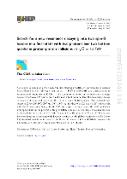Search for a new resonance decaying into two spin-0 bosons in a final state with two photons and two bottom quarks in proton-proton collisions at √s=13 TeV

Author
Tumasyan, A.
Adam, W.
Andrejkovic, J. W.
Bergauer, T.
Chatterjee, S.
Damanakis, K.
Dragicevic, M.
Del Valle, A. Escalante
Hussain, P. S.
Jeitler, M.
Publication date
2024Published in
Journal of High Energy PhysicsVolume / Issue
neuveden (5)ISBN / ISSN
ISSN: 1029-8479Metadata
Show full item recordCollections
This publication has a published version with DOI 10.1007/JHEP05(2024)316
Abstract
A search for a new boson X is presented using CERN LHC proton-proton collision data collected by the CMS experiment at root s = 13 TeV in 2016-2018, and corresponding to an integrated luminosity of 138 fb(-1). The resonance X decays into either a pair of Higgs bosons HH of mass 125 GeV or an H and a new spin-0 boson Y. One H subsequently decays to a pair of photons, and the second H or Y, to a pair of bottom quarks. The explored mass ranges of X are 260-1000 GeV and 300-1000 GeV, for decays to HH and to HY, respectively, with the Y mass range being 90-800 GeV. For a spin-0 X hypothesis, the 95% confidence level upper limit on the product of its production cross section and decay branching fraction is observed to be within 0.90-0.04 fb, depending on the masses of X and Y. The largest deviation from the background-only hypothesis with a local (global) significance of 3.8 (below 2.8) standard deviations is observed for X and Y masses of 650 and 90 GeV, respectively. The limits are interpreted using several models of new physics.
Keywords
B Physics, Hadron-Hadron Scattering, Higgs Physics, Photon Production,
Permanent link
https://hdl.handle.net/20.500.14178/2987License
Full text of this result is licensed under: Creative Commons Uveďte původ 4.0 International






